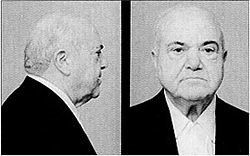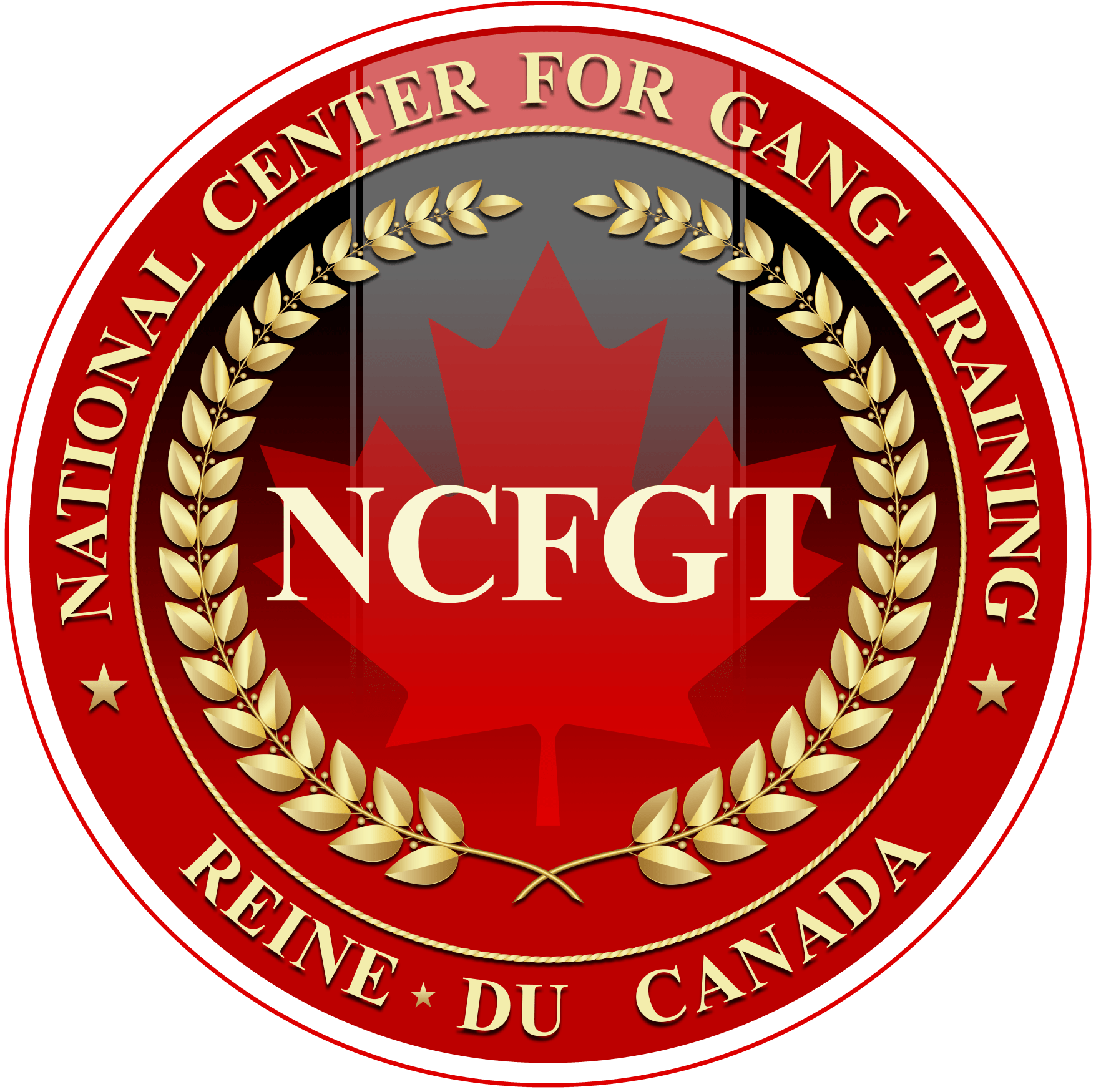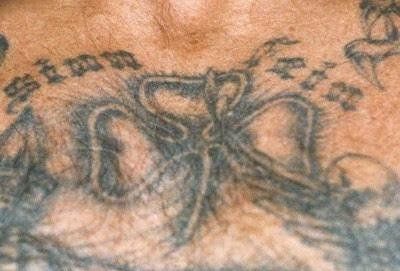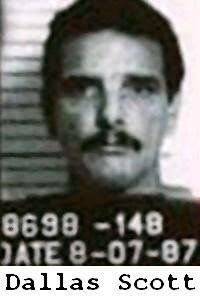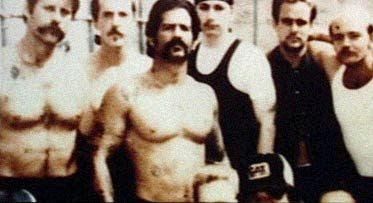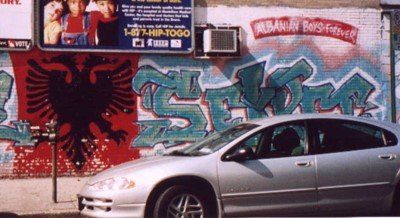Aryan Brotherhood
AB members are known to have Viking & Celtic tattoos, including the runic alphabet. Norse symbols are not gang affiliated, and are commonly used by Odinists (racist & non-racist).
The slogan Sinn Fein, Irish for "ourselves alone," is a recent AB tattoo (No relation to the Sinn Féin political party in Ireland).
Sworn code of the AB:
I will stand by my brother.
My brother will come before all others.
My life is forfeit should I fail my brothers.
I will honor my brother in peace as in war.
Aryan Brotherhood Pledge:
An Aryan brother is without a care,
He walks where the weak and heartless won’t dare,
And if by chance he should stumble and lose control,
His brothers will be there, to help reach his goal,
For a worthy brother, no need is too great,
He need not but ask, fulfillment’s his fate.
For an Aryan brother, death holds no fear,
Vengeance will be his, through his brothers still here.
As legend has it the Aryan Brotherhood formed at San Quentin Prison in California in 1967 in the cauldron of the prison race wars to fight the Black Guerrilla Family, a black prison gang led by the notorious Black Panther, revolutionary and author of Soledad Brother, George Jackson. The white supremacist group, which later became known as the Brand was originally comprised of prisoners of Irish descent and former members of 50's biker tips such as the Diamond Tooth gang and the Bluebird gang. The tips came together in the gladiator school style type prisons under a neo-Nazi banner. The Aryan Brotherhood was for whites only and its members were the most violent and ferocious of their race. By 1975 the gang was all throughout the California system.
As their notoriety increased and membership grew they established a chain of command modeled loosely on the structure of the Italian Mafia with commission that communicated via correspondence through 3rd parties passing orders to their prison based branches all across the US. The 3 man commissions were also a way to channel the gangs’ violence and resolve in-house feuds. They established drug trafficking, security, extortion and gambling rackets in prisons all over the country. The leaders who had multiple life sentences worked out of solitary confinement cells in some of the most secure prisons in the world. From Pelican Bay, the supermax in California, and ADX Florence, the Alcatraz of the Rockies, the Brand ran a prison empire through coded invisible ink letter. The FBI investigated them from 1982 to 1989, but the US Attorney declined prosecution. But the FBI reported that "the purpose of the AB is now power Bureau officials claim that Dallas and is not a racial organization as it has been in the past."
Scott was a founding member of the Aryan Brotherhood.
They even took a hit from John Gotti, the Mafioso, who offered the Brand $100,000 to kill the black prisoner who assaulted him at USP Marion in 1996.
On August 28, 2002, AUSA Greg Jessner indicted virtually the entire leadership of the gang. The indictment reached back 20 years spanning 3 decades and 32 murders. Forty members were indicted of federal racketeering charges in a 140, 10 count indictment. The majority of the gang members were already doing life sentences, so 23 of them are eligible for the death penalty. "This is a homicidal organization," Jessner announced. "That’s what they do. They kill people I suspect they kill more than the Mafia. They may be the most murderous criminal organization in the United States." The indictment is the largest capital case in the history of California and the AUSA indicted the Brand, a prison gang with laws originally passed to target Mafia leaders. "Inmates and others who do not follow orders of the AB are subject to being murdered as is anyone who uses violence against an AB member or anyone who cooperates with law enforcement." The indictment reads.
US vs. Mills, No CR02-938 (C) (C.D. Calif.) is the docket number and the alleged leaders of the Brand have become legendary figures. Barry Byron "The Baron" Mills, aged 57 and TD Tyler Davis "The Hulk" Bingham, aged 58 are the leaders of the Aryan Brotherhood the government alleges. The indictment says that they've orchestrated the brotherhoods campaign from their cells at ADX, the federal supermax. Mills is doing life for a 1979 prison murder, but Bingham is scheduled for release in 2012, but if both are convicted they'll face the death penalty.
Another primary in the case is Thomas "Terrible Tom" Silverstein who started the AB-DC Black race war by killing Raymond "Cadillac" Smith, the leader of the DC Blacks in 1982 by stabbing him 67 times in the Marion Control Unit. "Within the gangs’ lore, Silverstein has become the Christ figure," AUSA Jessner said. And the race war with the DC Blacks is the central factor in the government’s case as the 1997 killing of 2 DC Blacks at USP Lewisburg was allegedly ordered by Bingham in an invisible ink message written in urine.
AB members at USP Leavenworth
AB members in an exhibit in the narcotics-trafficking trial of Michael "Big Mac"
McElhiney (shirtless) who co-ran AB operations at the U.S. Penitentiary at Marion, Illinois.
Enemies of The Brand
The AB was originally formed to fight the Black Guerrilla Family, which was founded in San Quentin by George Jackson in 1966. The Former Black Panther, revolutionary and author of Soledad Brother had a vile hatred of the system and all things white. The BGF would beat, kill and maim random white when they caught them out of their cells for no other reason than that they were white. This cauldron of hate and atmosphere of tension, which existed at San Quentin at the time fermented the race wars in the California system and led to the rise of the big four prison gangs, which were divided along racial lines-The Aryan Brotherhood, Black Guerrilla Family, Mexican Mafia and Nuestra Familia. The BGF allied with the Nuestra Family and fought a constant battle against the AB's who allied with the Mexican Mafia who was constantly at war with their counterparts from the northern part of California, Nuestra Familia while they represented the southern part of California.
The BGF was the most politically oriented of the gangs. It was formed as a revolutionary organization along paramilitary lines. Its goal was to overthrow the US government. They were led by a Supreme Commander or Chairman and the lowest echelon of gang members were known as soldiers. They originated out of the MAD Adjustment center at San Quentin, the first SHU in the country. They recruit members of black street gangs like the Crips, disenchanted members of radical black organizations and are aligned with the Black Liberation Army. Their founder George Jackson was killed by guards at San Quentin in the early seventies. A victim of his fame and notoriety.
The race wars in the federal system started on Nov 22, 1981 when the body of Robert M. Chappelle, a member of the DC Blacks was found dead in his cell at USP Marion. Thomas Silverstein was the killer and Chappelle’s death worried bureau official who thought it might spark a war, which it certainly did.
Raymond "Cadillac" Smith, the alleged national leader of the DC blacks was the next person killed. Terrible Tom struck again on Sept 27, 1982 stabbing Cadillac 67 times in the Marion control Unit and dragging his body up and down the tier so that those locked in their cells could see. The race wars against the DC blacks raged across the feds in the early 1980's and again in the 1990's when 2 DC blacks were killed at USP Lewisburg by AB members who stabbed them 35 and 34 times to death. The violent campaign against the DC Blacks and the alleged race war are at the center of the government’s 2002 indictment against the Aryan Brotherhood.
The DC Blacks are prisoners from Washington DC who usually make up the largest single ethnic group from any single city making up 10 percent of the overall federal prison population. They are well schooled in violence from their time spent at Lorton the infamous DC penitentiary, and are known as notorious locker knockers, petty thieves and for pressuring prisoners for sex. A lot of DC Blacks were members of the Moorish religion at one time.
"The most ferocious and notorious of any of the prison groups is the Aryan Brotherhood," the FBI reported. Over its four decade history the gang has evolved from an organization focusing on aggression against blacks to a violent white supremacist group that runs sophisticated gambling, extortion and dope operations in prison across the nation.
The Brand as the gang is called makes it members read The Art of War by Sun Tzu, Machiavelli's, The Prince and Nietzsche's Will To Power, as well as, exercising vigorously to stay in shape and studying Gray's Anatomy books, so as to know where to stab enemies and inflict killing blows. They've been accused of running-a barbed wire empire of terror, drugs and extortion. The case reached back 40 years to include stabbings, strangulations, poisonings, contract hits, conspiracy to commit murder, robbery and narcotics trafficking. A brief history of the gang:
Aryan Brotherhood Lexicon
The Brand- the name the brotherhood is known by to members and refers to the shamrock or clover leaf tattoo found on members that denotes membership and signifies the Brand.
Blood In, Blood Out- This is the process by which someone is accepted into the gang meaning they have to kill to get in and the only way to get out is by death.
Making Your Bones- This is the initiation into the gang. When you kill someone to get in it is called making your bones.
Rocking Someone To Sleep- This is the process of disarming a target for murder by making him think you are friends. By rocking someone to sleep it makes them easier to kill when they aren't expecting it.
Lie or Die- When questioned by law enforcement types the Brand's motto is to lie or die because if you tell the truth and cooperate with law enforcement you will be marked for death, so you must lie to them and make them think you are telling the truth.
Getting Writted- This is when one AB member has a case and his defense lawyer gets all his brothers and fellow gang members writted in to be defense witnesses in the case at hand so that all the brotherhood members can be gathered at one place to discuss gang business.
Keistered- This is when a gang member in transit or in the hole sticks contraband such as drugs, tobacco or shanks up his ass so that it won't be found in strip searches and body searches.
In the Hat- this term is used when someone is marked or targeted for death. If someone is in the hat in gang parlance it means he will be killed soon.
Burpees- this exercise consisting of a combination of pushups and jumping jacks is performed by AB members on lockdown to stay in good shape. Sometimes thousands of burpees will be done a day.
Polishing the Rock- this term refers to gang members on the outside doing things to further gang and brotherhood business on the outside. Before leaving prison they will be urged to keep polishing the rock.
Kytes- this is what letters or notes to fellow prisoners are called. They might be in invisible ink or coded and are often sent via transferring prisoners or via a third party on the outside who will mail it to the appropriate gang member. Kytes typically contain instructions and order for furthering brotherhood business.
Runners- this term refers to girlfriends, associates and people on the outside who help the gang to achieve their goals by ferrying messages into and out of various prisons. They also gather mail at designated mail drops and forward them to other gang members in different prisons, smuggle drugs for the brotherhood into prisons through the visiting rooms and gather and collect monies sent to the higher ups in the gang either to put on their account or to pay for more drugs coming into the prisons,
Prisons (and jails) that have reported AB activity in the past 3 years
* San Quentin State Prison in California
* California State Prison in California
* Pelican Bay State Prison in California
* USP Marion Federal Prison in Illinois
* Folsom State Prison in California
* California Institution for Men in California
* Harris County Jail in Texas
* Estelle High-Security Unit in Texas
* Garner Correctional Institution in Connecticut
* Lompoc Federal Prison in California
* High Desert State Prison in Nevada
* Central Mississippi Correctional Facility in Mississippi
Allies: Mexican Mafia, Hells Angels, PENI, Nazi Low Riders
Rivals: La Nuestra Familia, Black Guerilla Family, DC Blacks
